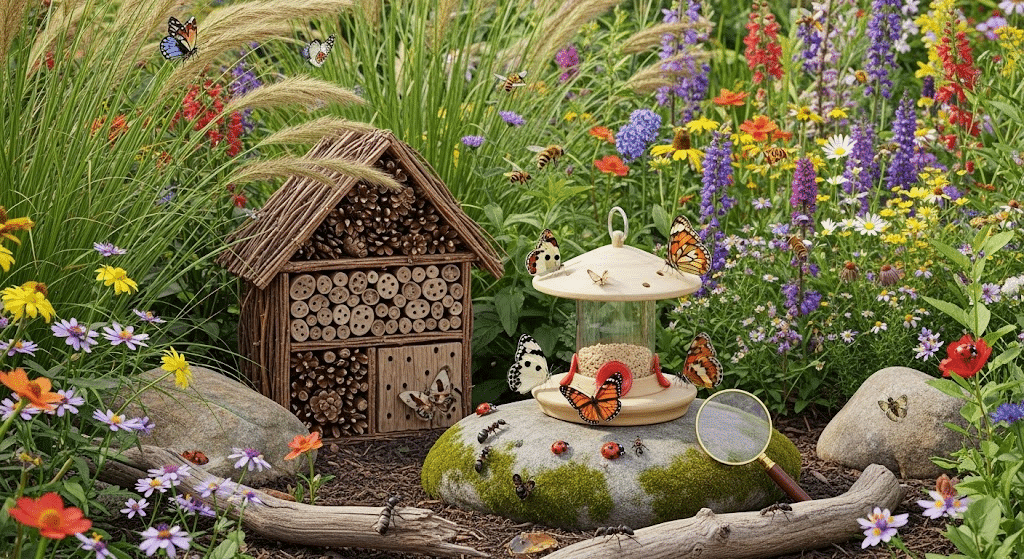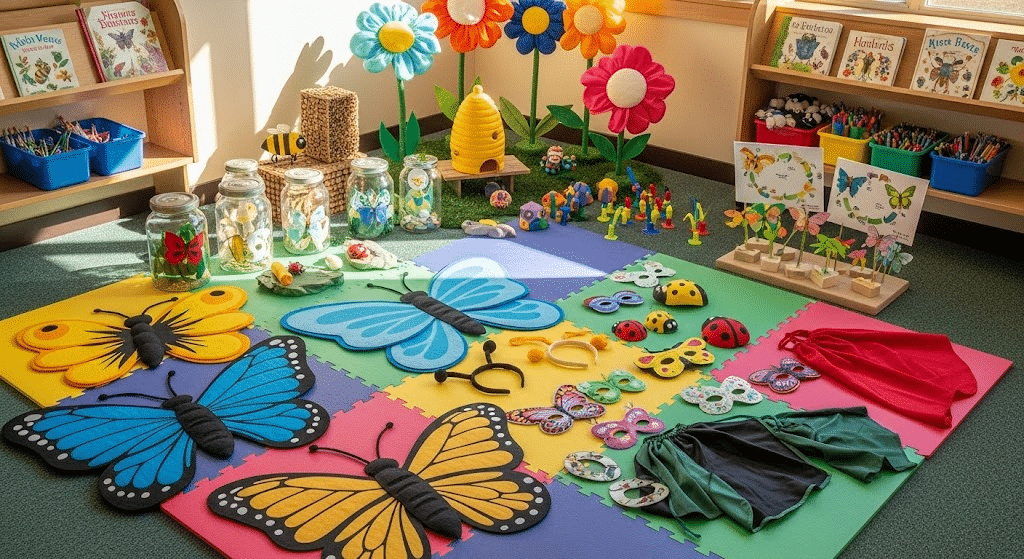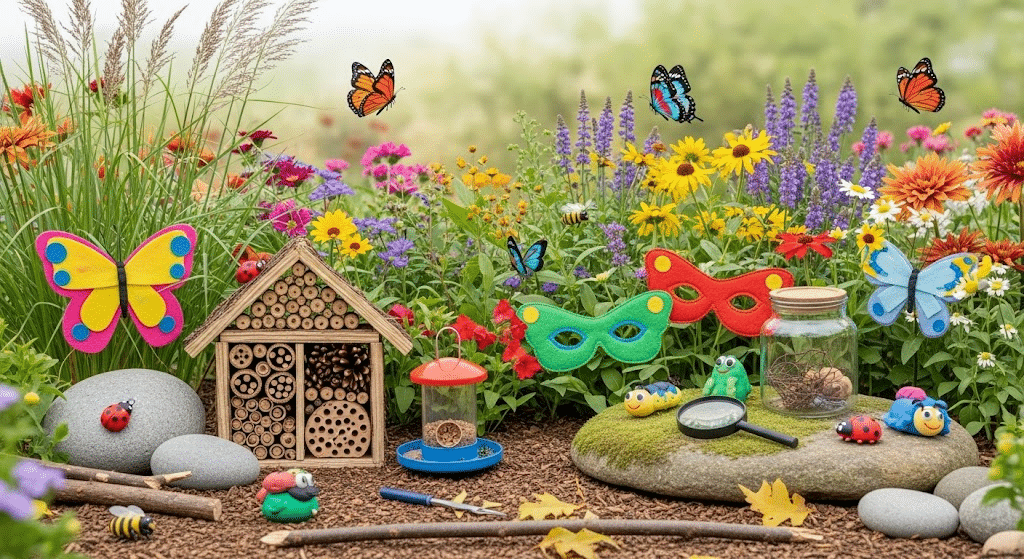Children are curious and find magic in the smallest creatures around them. Watching a butterfly flutter or an ant march can captivate young minds for hours.
When it comes to nurturing curiosity, few topics excite preschoolers like the world of insects.
Insect activities for preschoolers offer the perfect blend of fun and learning. These hands-on experiences help children develop observation skills, learn about nature, and build confidence through play.
This blog will show you easy ways to bring insect learning into your preschooler’s day. From indoor crafts to outdoor explorations, these activities will spark wonder and support your child’s growth.
Why Insect Activities for Preschoolers Matter?
Insect activities for preschoolers offer a rich learning experience that goes far beyond simple fun. When children observe a ladybug crawling on their hand or watch ants building their home, they engage multiple senses at once.
The texture of a butterfly’s wing, the sound of buzzing bees, and the sight of colorful beetles all work together to create powerful sensory memories that stick with young learners.
These hands-on experiences also help develop fine motor skills in natural ways.
Picking up small insects with tweezers, drawing bug shapes, or building insect habitats all require careful hand movements. Children practice pinching, grasping, and coordinating their fingers without even realizing they’re working on important physical skills.
The emotional benefits are just as valuable. Many children start out feeling scared or unsure about bugs, but gentle exposure helps them build confidence and overcome their fears.
Insect Themed Activities for Preschoolers
Spark curiosity and hands-on learning with these insect activities for preschoolers.
From outdoor bug hunts and sensory bins to creative crafts and dramatic play, each activity helps children learn and understand the fascinating world of insects.
Hands-On & Outdoor Activities

These engaging experiences, like bug scavenger hunts, sensory bins, and bug hotel building, help children observe real insects, develop scientific thinking, and connect with nature through active play and investigation.
1. Bug Scavenger Hunt
Children embark on an outdoor adventure, sharpening their observation skills while searching for insects in their natural environment. This activity fosters curiosity and a deeper appreciation for the diversity of bugs around them.
Key Benefits:
- Encourages teamwork as children collaborate to find and identify bugs on their checklist.
- Promotes critical thinking by having kids compare similarities and differences between insects.
- Provides opportunities to learn about insect habitats and the roles bugs play in the ecosystem.
2. Insect Sensory Bin
Through hands-on play with bug-themed materials, children explore textures, shapes, and sizes, enhancing their sensory awareness. This activity supports language development as kids describe their discoveries.
Key Benefits:
- Stimulates imagination by encouraging pretend play scenarios with insects.
- Supports fine motor development as children use tweezers, scoops, or their fingers to manipulate objects.
- Introduces basic math concepts by sorting bugs by color, size, or type.
3. Bug Hotel Building
Constructing bug hotels teaches children about the needs of insects and the importance of providing safe habitats. Kids gain practical skills and a sense of responsibility as they create welcoming spaces for beneficial bugs.
Key Benefits:
- Inspires creativity as children design and decorate their own bug hotels using various natural materials.
- Promotes sustainability by using recycled or found items in construction.
- Encourages observation of which insects visit or inhabit the hotel over time.
4. Butterfly Feeder Craft
Making butterfly feeders helps children understand insect nutrition and the importance of supporting pollinators. Kids enjoy hands-on crafting while learning about the life cycle and behaviors of butterflies.
Key Benefits:
- Teaches measurement and simple math when mixing nectar solutions.
- Provides ongoing observation opportunities as butterflies visit the feeders.
5. Bug Investigation Lab
Children become mini scientists, closely examining insects with magnifying tools and recording their findings. This activity nurtures curiosity and scientific inquiry.
Key Benefits:
- Builds vocabulary as kids label insect body parts and features.
- Fosters documentation skills through drawing or writing about observations.
- Encourages respectful handling and release of live insects after study.
6. Insect Exploration Kits
Equipped with bug-catching tools and guides, children independently explore the world of insects. This activity boosts confidence and a sense of adventure.
Key Benefits:
- Promotes responsible collecting and gentle handling of insects.
- Supports identification skills using field guides or reference cards.
- Inspires journal-keeping or photo documentation of insect discoveries.
7. Insect-Themed Obstacle Course
By mimicking insect movements, children engage in active play that strengthens their bodies and imaginations. This activity combines physical development with creative expression.
Key Benefits:
- Encourages teamwork and cooperative play as children complete the course together.
- Introduces basic biology concepts by discussing why insects move in certain ways.
- It can be adapted for indoor or outdoor settings, making it versatile for any group size.
Creative & Dramatic Play Activities

These activities like making butterfly wings, bug fossils, and role-playing as bees or gardeners help children express themselves, build social skills, and deepen their understanding of insects through hands-on, imaginative experiences
8. Butterfly Life Cycle Craft
Children gain a hands-on understanding of metamorphosis by crafting each stage of a butterfly’s life, from egg to adult. This activity reinforces sequencing skills and natural science concepts while building fine motor abilities.
Key Benefits:
- Strengthens understanding of biological life cycles and the concept of change in nature.
- Encourages following multi-step directions, supporting cognitive development and memory.
- Enhances fine motor skills through cutting, gluing, and assembling small craft pieces.
9. Play-Dough Bug Fossils
By pressing toy insects into dough, kids create fossil impressions, learning about preservation and ancient life. This sensory-rich activity blends science, creativity, and tactile exploration.
Key Benefits:
- Develops hand strength and coordination by manipulating dough and pressing objects.
- Introduces basic paleontology concepts, fostering curiosity about how fossils form.
- Promotes observation and matching skills as children compare real bugs to their imprints.
10. Felt Butterfly Wings
Children design and wear their own butterfly wings, combining art with imaginative play. This project nurtures creativity and self-expression while teaching about butterfly anatomy and movement.
Key Benefits:
- Builds planning and sequencing skills as kids design, cut, and assemble their wings.
- Reinforces color recognition and pattern creation through decoration choices.
- Encourages dramatic play, helping children understand butterfly flight and behavior.
11. Bugs in a Jar Counting Game
Young learners use bug counters and jars to practice counting, sorting, and number recognition in a playful, hands-on way. This math activity makes abstract concepts concrete and engaging.
Key Benefits:
- Supports one-to-one correspondence and number sense through hands-on manipulation.
- Encourages sorting and grouping, building early math and logic skills.
- Promotes turn-taking and cooperative play when used in group settings.
12. Role-Playing Bee Pollination
Children act out the role of bees, collecting and transferring pollen between flowers. This dramatic play builds awareness of pollination and the importance of teamwork in nature.
Key Benefits:
- Teaches the ecological role of bees and their impact on food production and biodiversity.
- Develops social skills and cooperation as children work together to “pollinate” flowers.
- Encourages movement and gross motor skills through active play.
13. Ladybug Count and Clip Cards
Kids match quantities by clipping clothespins to numbered ladybug cards, practicing counting and fine motor skills. This self-correcting activity fosters independence and math readiness.
Key Benefits:
- Strengthens hand muscles and coordination through the use of clothespins.
- Builds number recognition and counting accuracy.
- Allows for self-paced, independent learning with immediate feedback.
14. Host a Beekeeper Dramatic Play Center
Children explore the world of beekeeping with costumes and props, learning about insect care and the role of beekeepers. This imaginative center encourages social interaction and real-world connections.
Key Benefits:
- Enhances vocabulary and communication as children discuss beekeeping tasks and tools.
- Promotes teamwork and role negotiation during group play.
- Introduces concepts of honey production, hive care, and environmental stewardship.
15. Bug-Themed Picture Book Reading
Interactive story time with insect-themed books helps children connect literature to real-world experiences. This activity supports literacy and a deeper appreciation for bugs.
Key Benefits:
- Builds comprehension, listening, and vocabulary through engaging stories.
- Fosters curiosity about insects and their roles in the ecosystem.
- Encourages discussion and connection between books and hands-on insect activities.
Where to Find Insect Activity Resources
| Resource Type | Where to Find It | Highlights |
|---|---|---|
| Trusted Online Sources | Teachers Pay Teachers, Pinterest, Education.com, Crayola.com, YouTube, blogs | Free & paid printables, videos, craft tutorials, and lesson ideas |
| DIY Household Tools | Common items like yogurt cups, tongs, egg cartons, pipe cleaners, paper plates | Cost-effective, creative ways to make bug viewers, magnifiers, and craft kits |
| Nature Center Programs | Local nature centers | Hands-on bug exploration with expert guidance in a safe environment |
| Museum Educational Kits | Children’s museums & their websites | Take-home kits or downloadable resources with curated, age-appropriate content |
To Conclude
Insect activities for preschoolers open doors to wonder that can last a lifetime.
When children feel comfortable finding the tiny creatures around them, they build confidence to tackle bigger questions about the world.
These simple bug-focused experiences teach patience, observation skills, and respect for all living things. Parents and teachers should feel encouraged to step back and let kids lead their own insect investigations.
Start small this week: “Try letting your child choose an insect of the week to study together!”


















